Urea (urea): terms and rules for the use of fertilizers in the garden and vegetable garden
What gardener has not heard of urea or carbamide (these are synonyms), because it is one of the most effective and popular nitrogen fertilizers. However, by no means every summer resident knows all the nuances and rules for using urea in the garden and vegetable garden.
After reading this material, you will learn:
- what is urea, how it looks, how much nitrogen it contains and in what form;
- how to properly use urea in the garden and vegetable garden: what are the methods of fertilizing (for the main application to the garden, as well as root and foliar feeding);
- what are the rates for applying this nitrogen fertilizer for feeding certain crops;
- how to use urea for eradicating garden treatments in spring and autumn.
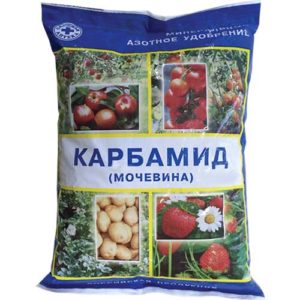
Content
What is urea: chemical composition and scope
Urea (carbamide) - this is the most popular mineral nitrogen fertilizer (in second place - ammonium nitrate).
Moreover, urea is the most concentrated nitrogen fertilizer (46% nitrogen).
Urea contains nitrogen in amide form... Chemical formula - (NH2)2CO, carbonic acid diamide.
Urea is available in the form granules white.
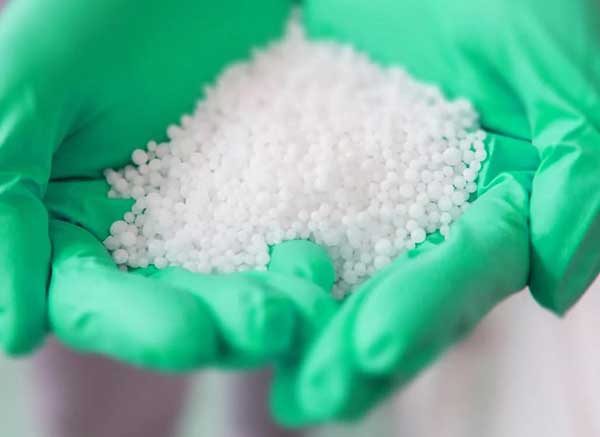
It is used as a nitrogen fertilizer for all crops on all types of soils (read about the features of application and dosages below).
By the way! About,why are nitrogen fertilizers (including urea) needed (what are the benefits of them for plants), detailedin this material.
Humated urea
Now on sale you can find humated urea. It differs from the usual one by the presence potassium humate, which improves the growth of the ground and root parts of plants, increases the resistance of plants to adverse environmental influences, diseases and pests, helps to increase product yields, and reduce the content of nitrates. Also, humate allows you to increase the efficiency of assimilation of mineral components of fertilizers (trace elements) by converting them into a form more accessible to plants.
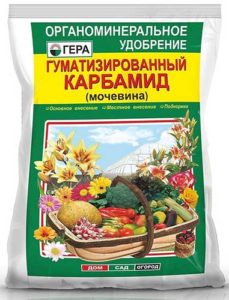
When and how to use urea in the garden and vegetable garden: methods and rules of fertilization
Terms and methods of deposit
Nitrogen in amide formis best absorbed by plants through the leaves. Accordingly, it is optimal to carry out exactlyfoliar top dressing (spraying) with urea solution.
However, urea can also be used for early spring preparation of the beds (introduction for digging) and liquid dressings under the root during the growing season.
In other words, urea is used in early spring when preparing the garden, when planting seedlings or sowing seeds, and in the initial growing season, before flowering / beginning of fruiting (from April to mid-July).
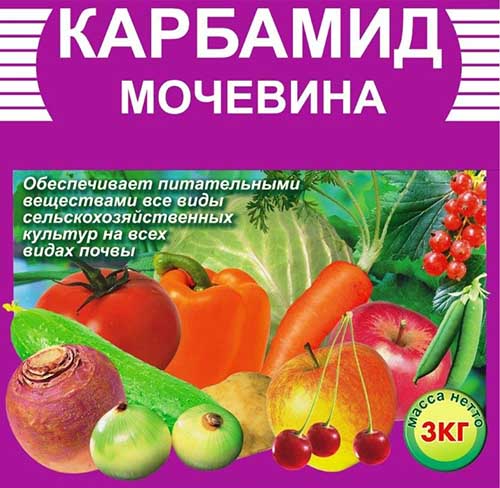
Application rules
- Urea does not work at low positive temperatures (optimal - above +10 .. + 20 degrees).
Remember! When it's cold and in the snow introduced ammonium nitrate, after get warmer — urea (urea).
- Urea is very well soluble in water (you can simply in water at room temperature or slightly warm, but optimally hot - 50-60 degrees).
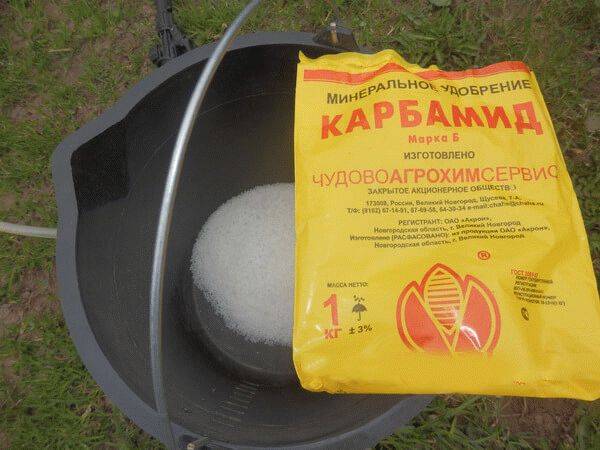
- You can only spill liquid mineral fertilizers on the already wet ground (i.e. after watering) so as not to burn the roots of young plants.
- Urea solution does not burn the leaves (as opposed to ammonium nitrate), therefore ideal for foliar dressing (spraying over the leaves).
- Unlike ammonium fertilizers (ammonium sulfate and ammonium nitrate), urea granules are necessary always embed in soil to reduce the loss of ammonia (nitrogen), because he quickly evaporates in the air.
Note! With the surface application of urea, in other words, if you just scatter urea granules without embedding in the soil, then in the absence of precipitation (without irrigation), part of the nitrogen in the form of ammonia will simply evaporate. Moreover, this is especially pronounced on soils with a neutral and alkaline reaction.
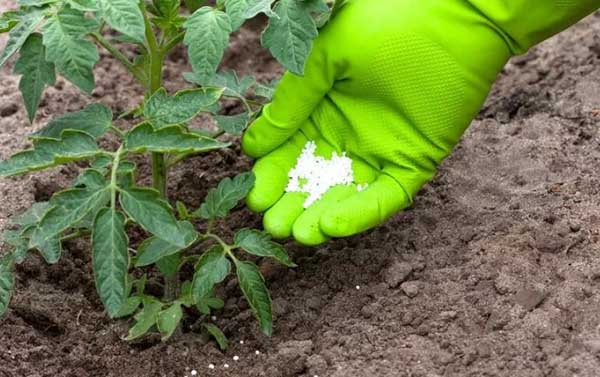
- Urea does not work immediately, so it can be called slow-acting nitrogen fertilizer (Unlike ammonium nitratewhich acts almost instantly).
For nitrogen in the amide form to become available to plants, some time must pass and a whole chain of chemical and biological transformations must take place (nitrogen from the amide form must go into the ammonium form and then into the nitrate form).
However! With foliar application (spraying with a solution on the leaves), urea begins to act quickly enough (within 48 hours).
- To make urea well absorbed, the soil must be rich in organic matter (and urobacteria), in other words, its preferably applied together with humus or compost.
- Urea it is not recommended to mix (add simultaneously) with alkaline fertilizers, for example, with wood ash or again with lime, dolomite flour, in chalk, as this (reaction) will lead to the loss of ammonia (nitrogen) and highlighting unpleasant odor which in turn can provoke ammonia plant poisoning = toxic shock (especially important for closed ground - greenhouses).
- Accordingly, if you have alkaline soilthen using urea is not recommended.
- If you want to add urea directly to the hole when planting seedlings (or in rows when sowing seeds), then together with her it is desirable to add and potassium sulfate (potassium sulfate) and / or superphosphate.
Application rates
You can always find calculated dosages for fertilizing and feeding various crops with urea in the instructions on the package.
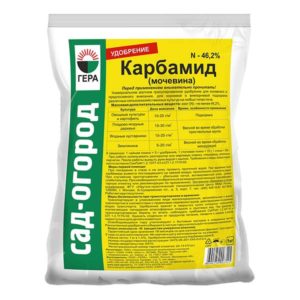
By the way! Recommended Urea Dose for Most Crops - this 1 tbsp. spoon (10-12 grams) for 10 liters of water (for solution preparation) or for 1 square meter (in dry form for embedding in soil).
However, much more often they use matchbox (13-15 gr).
IN faceted glass - 130-150 gr.
To prepare the garden (spread evenly over the surface and quickly embed into the soil):
- For cultivated soils - 20-30 grams. per sq.m.
- For uncultivated soils - 30-40 gr. per sq.m.
- Beets, carrots, cabbage, potatoes - 20-30 gr. per sq.m.
- Tomato, pepper, eggplant, cucumber, pumpkin - 15-20 gr. per sq.m.
- Decorative and flower crops - 15-20 gr. per sq.m.
- Radishes, onions and green crops (greens) - 5-10 gr. per sq.m.
When growing tomatoes and cucumbers in a greenhouse, the application rate should be increased by 1.5 times, i.e. up to about 20-30 gr.
For root feeding (evenly distribute around the tree trunk circle of plants, gently embed it in the soil, and then water, or immediately prepare a solution for 10 liters of water and water):
- Vegetable crops - 5-15 gr. per sq.m. or 10 liters.
- Berry bushes - 15-20 gr. per square meter (for smaller strawberries - 10-15 gr).
Strawberries (garden strawberries) can be fed with urea 2 times — in spring and summer immediately after harvest.
By the way! The site has an article about how to care for strawberries after fruiting.
- Fruit trees - 20-30 gr. per square meter (in a young tree, the trunk circle is usually about 1.5-2 m, in an older and fruiting tree - from 3 to 5 m).
For foliar feeding (spraying on leaves):
- Vegetable crops - 50-60 gr. 10 liters.
Important! Spraying is carried out strictly before flowering.
- Berry bushes and fruit trees - 20-30 gr. 10 liters.
Solution consumption: 1-2 liters per bush or young tree, per adult - 5-8 liters.
Note! Top dressing is carried out after flowering (after 5-7 days) and again after 25-30 days.
Spring and autumn eradicating treatment of trees and shrubs with urea
Urea is also often used as fungicide and insecticide for eradicating early spring (the very first) andautumn spraying (the very last one).
Typically, a urea eradication solution is prepared as follows:
- In 10 liters of water, dissolve 500-700 grams of urea (it is better initially dissolve in 1-2 liters of warm water, and then add cold water).
Important! 500-700 grams of urea is a high concentration for leaves (they will all burn), but not for bare branches. Therefore, in the fall, processing is carried out after leaf fall (but it is possible earlier), and in the spring - before bud break.
- Further to improve the effectiveness of eradicating autumn treatment garden, it is very desirable to also add 300-500 grams ferrous sulfate, and spring - 100-300 gr. copper sulfate.
By the way! Spring treatment with urea also delays bud opening and, accordingly, flowering. After all, it is especially important that return frosts have time to go through before flowering.
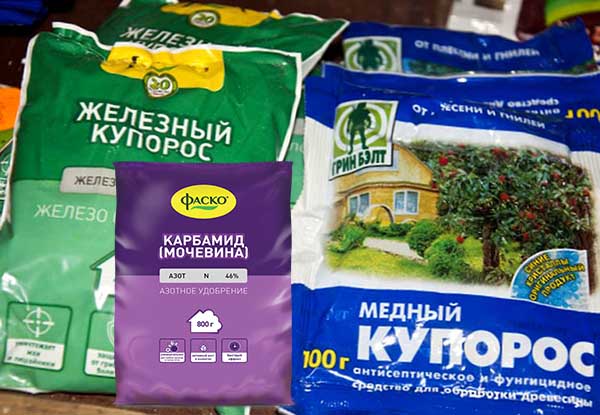
- For better adhesion of the solution it is also desirable to add 200-250 ml liquid soap (only not economic) or dishwashing liquid.
- Pour into a sprayer and thoroughly process trees and shrubs.
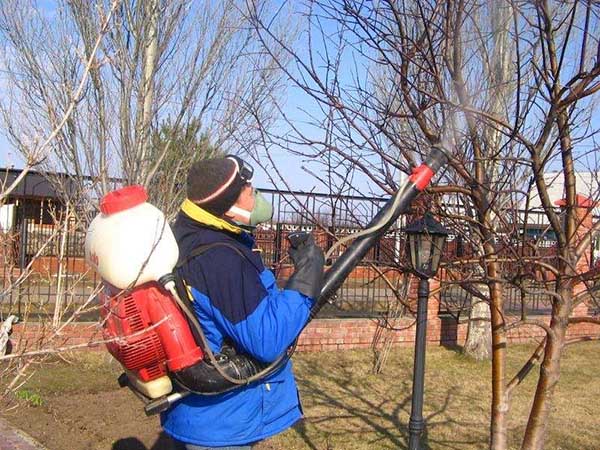
Note! Everyone knows that urea is a nitrogen fertilizer, which means that in the autumn it can provoke the growth of shoots.But in view of the fact that the treatment is carried out shortly before the first frost, urea does not cause any effect other than "eradicating" (fungicidal and insecticidal). Therefore, there is nothing to be afraid of.
Do not be afraid to use mineral nitrogen fertilizers in the garden for feeding vegetables, fruit and berry crops! If in doubt, add them along with organic matter. And this is even desirable: this way urea will work even better.

